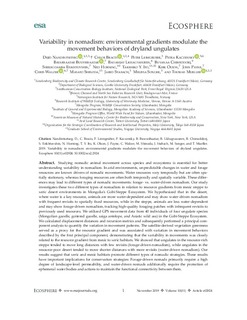Variability in nomadism: environmental gradients modulate the movement behaviors of dryland ungulates
Nandintsetseg, Dejid; Bracis, Chloe; Leimgruber, Peter; Kaczensky, Petra; Buuveibaatar, Bayarbaatar; Lkhagvasuren, Badamjav; Chimeddorj, Buyanaa; Enkhtuvshin, Shilegdamba; Horning, Ned; Ito, Takehido Y.; Olson, Kirk; Payne, John; Walzer, Chris; Shinoda, Masato; Stabach, Jared; Songer, Melissa; Mueller, Thomas
Journal article, Peer reviewed
Published version

View/
Date
2019Metadata
Show full item recordCollections
- Publikasjoner fra CRIStin - NINA [2364]
- Scientific publications [1392]
Original version
10.1002/ecs2.2924Abstract
Studying nomadic animal movement across species and ecosystems is essential for better understanding variability in nomadism. In arid environments, unpredictable changes in water and forage resources are known drivers of nomadic movements. Water resources vary temporally but are often spatially stationary, whereas foraging resources are often both temporally and spatially variable. These differences may lead to different types of nomadic movements: forage- vs. water-driven nomadism. Our study investigates these two different types of nomadism in relation to resource gradients from mesic steppe to xeric desert environments in Mongolia’s Gobi-Steppe Ecosystem. We hypothesized that in the desert, where water is a key resource, animals are more water-dependent and may show water-driven nomadism with frequent revisits to spatially fixed resources, while in the steppe, animals are less water-dependent and may show forage-driven nomadism, tracking high-quality foraging patches with infrequent revisits to previously used resources. We utilized GPS movement data from 40 individuals of four ungulate species (Mongolian gazelle, goitered gazelle, saiga antelope, and Asiatic wild ass) in the Gobi-Steppe Ecosystem. We calculated displacement distances and recursion metrics and subsequently performed a principal component analysis to quantify the variation in movement patterns. The satellite-derived vegetation greenness served as a proxy for the resource gradient and was associated with variation in movement behaviors described by the first principal component, demonstrating that the variability in movements was closely related to the resource gradient from mesic to xeric habitats.We showed that ungulates in the resource-rich steppe tended to move long distances with few revisits (forage-driven nomadism), while ungulates in the resource-poor desert tended to move shorter distances with more revisits (water-driven nomadism). Our results suggest that xeric and mesic habitats promote different types of nomadic strategies. These results have important implications for conservation strategies: Forage-driven nomads primarily require a high degree of landscape-level permeability, and water-driven nomads additionally require the protection of ephemeral water bodies and actions to maintain the functional connectivity between them. animal movement; arid; forage; nomadism; recursion; resource; ungulate; water Variability in nomadism: environmental gradients modulate the movement behaviors of dryland ungulates
